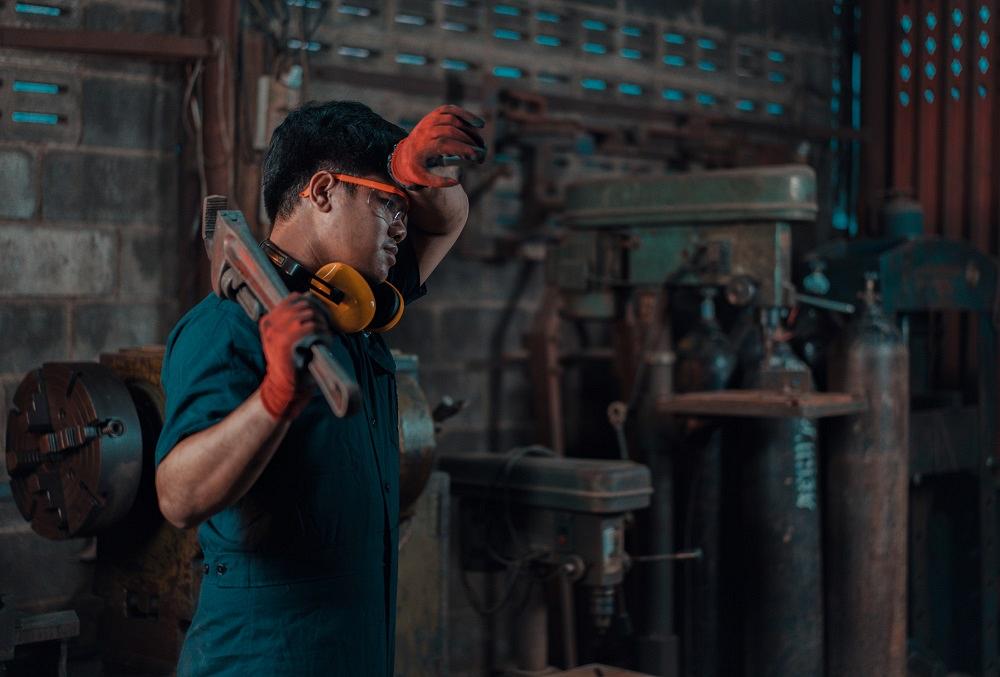- FMA
- The Fabricator
- FABTECH
- Canadian Metalworking
Categories
- Additive Manufacturing
- Aluminum Welding
- Arc Welding
- Assembly and Joining
- Automation and Robotics
- Bending and Forming
- Consumables
- Cutting and Weld Prep
- Electric Vehicles
- En Español
- Finishing
- Hydroforming
- Laser Cutting
- Laser Welding
- Machining
- Manufacturing Software
- Materials Handling
- Metals/Materials
- Oxyfuel Cutting
- Plasma Cutting
- Power Tools
- Punching and Other Holemaking
- Roll Forming
- Safety
- Sawing
- Shearing
- Shop Management
- Testing and Measuring
- Tube and Pipe Fabrication
- Tube and Pipe Production
- Waterjet Cutting
Industry Directory
Webcasts
Podcasts
FAB 40
Advertise
Subscribe
Account Login
Search
Technology Spotlight: Keep your cool—in any manufacturing environment
Personalized air conditioning can help individuals maintain comfort in hot metal fabrication job shops
- By Sue Roberts
- May 22, 2020
- Article
- Safety

Summer is coming, and many fabricators and other manufacturing workers know staying cool on a shop floor during a heatwave isn't easy. That's why engineers at the University of Missouri are working to provide personal wearable air conditioning. Getty Images
Keeping warm in cool weather is fairly easy. Add a layer of clothing when you head outside. Grab those thick socks. Pull on some lined mittens. Don a cap to keep heat from escaping from the top of your head.
Cooling off during a heat wave is a different story and can be near impossible, unless you are lounging by a pool or have access to some sort of air conditioning.
Dr. Zheng Yan, assistant professor in the Department of Biomedical, Biological, and Chemical Engineering and the Department of Mechanical & Aerospace Engineering at the University of Missouri, is working to provide personal air conditioning by combining chemical manipulation, material innovations, and advanced manufacturing to develop new functional materials with their own unusual micro- and nanostructures. The device, being produced as a patch during development, adheres to the body and reduces the temperature of the skin below it.
Referred to as wearable air conditioning, the breathable, waterproof device provides passive cooling without the need for electricity or restricting the individual’s movement. As an added benefit, it also monitors various health indicators such as blood pressure, heart rhythm, and skin temperature.
Dr. Yan answered questions about this new technology for The FABRICATOR.
The FABRICATOR: What prompted the development of this technology?
Yan: Maintaining the thermal comfort of people’s bodies in hot weather is one of the most basic needs for life and is generally achieved with external devices including air conditioners and fans. The use of these electric-powered devices usually costs a considerable amount of energy. The wearable patch, developed at the University of Missouri, not only can cool people’s bodies in the daytime without needing electricity, but also monitor a variety of vital physiological signals and provide a warning sign before a health issue arises.
FAB: Please provide a brief explanation on how the passive cooling works.
Yan: The patch has judiciously engineered multiscale porous structures. It can reflect sunlight without heating up. Meanwhile, a human body can still dissipate heat through the patch, so the body heat won’t be trapped underneath. As a result, the patch-covered body areas exhibit around a 11-degrees-F lower temperature than the rest of the exposed skin.
FAB: How much of the body benefits from the cooling of the patch? How large is the patch itself?
Yan: It is the body area covered by the patch that benefits from the cooling. Limited by our lab facilities, we can make patches with a size of 88 cm2. However, our approach is compatible with industry manufacturing and can be easily scaled up.
FAB: Who do you anticipate as its primary users?
Yan: The cooling property can benefit professionals in industries where they need to work out in warm weather, such as construction workers, members of the general public, and soldiers who need to cool down on the battlefield. Cooling down by using the patch can prevent heat stroke or exhaustion.
FAB: When do you anticipate a wireless version of this device, and what benefits will the wireless option add for those wearing the patch?
Yan: With sufficient support, we can achieve a wireless version within two years. The integration of wireless functionality will enable wireless data transmission and real-time analysis of vital physiological signals from human bodies to improve human health care.
FAB: How long does one of the devices last?
Yan: Currently the device can stay on a person’s skin and be fully functional for around three days. We are working on extending the lifetime of this smart patch by improving its adhesiveness.
FAB: How do you dispose of a spent patch?
Yan: When a patch is no longer functional, it is fully recyclable.
FAB: What do you see for the future of this cooling technology and its availability on the market?
Yan: Since this novel technology is still under development, it is hard to comment on its future. The raw materials that we use are already commercialized, and that is assisting in its development. Perhaps we will be able to go to market within a year or two. We expect the price will be quite reasonable upon scalable manufacturing.
About the Author

subscribe now

The Fabricator is North America's leading magazine for the metal forming and fabricating industry. The magazine delivers the news, technical articles, and case histories that enable fabricators to do their jobs more efficiently. The Fabricator has served the industry since 1970.
start your free subscription- Stay connected from anywhere

Easily access valuable industry resources now with full access to the digital edition of The Fabricator.

Easily access valuable industry resources now with full access to the digital edition of The Welder.

Easily access valuable industry resources now with full access to the digital edition of The Tube and Pipe Journal.
- Podcasting
- Podcast:
- The Fabricator Podcast
- Published:
- 04/30/2024
- Running Time:
- 53:00
Seth Feldman of Iowa-based Wertzbaugher Services joins The Fabricator Podcast to offer his take as a Gen Zer...
- Industry Events
Pipe and Tube Conference
- May 21 - 22, 2024
- Omaha, NE
World-Class Roll Forming Workshop
- June 5 - 6, 2024
- Louisville, KY
Advanced Laser Application Workshop
- June 25 - 27, 2024
- Novi, MI
Precision Press Brake Certificate Course
- July 31 - August 1, 2024
- Elgin,

































